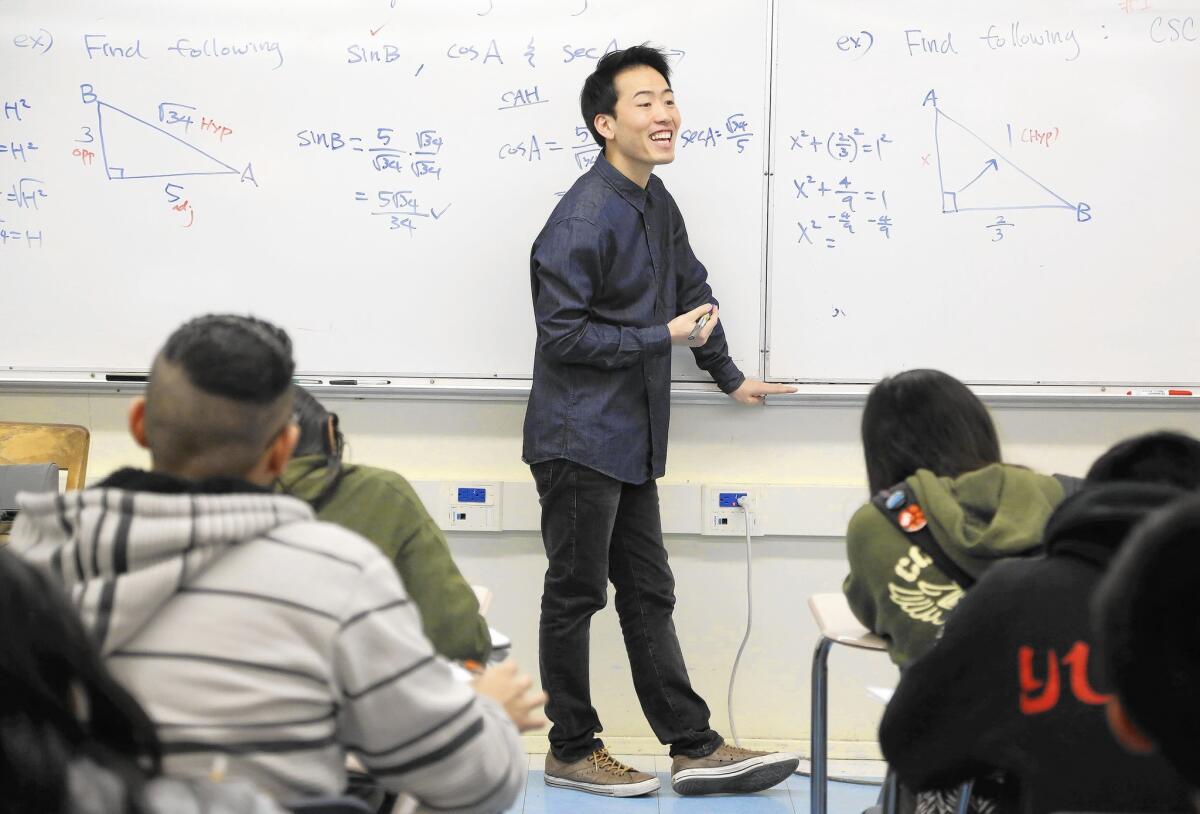Column: How a Lincoln High teacher gets all his students to pass the AP Calculus exam

Yom, as the students call their Lincoln High calculus teacher, is at the blackboard with marker in hand.
He can’t be stopped.
Left to right he works, light on his feet, flicking out triangles, stacking towers of numbers, turning Room 754 into a gallery of cave art.
And here’s the really impressive part:
Every student is locked in. There’s no daydreaming or goofing.
Join the conversation on Facebook >>
Twenty-five youngsters watch and listen as a smiling Anthony Yom takes his pre-calculus class on a right-angle trigonometry thrill ride through a maze of sines and cosines, out to prove that three squared plus five squared is going to equal H squared, or the world is off its axis.
“I am done teaching,” Yom finally says before starting students on their own problem-solving missions. “You need to get to work now.”
As they dig pencils into paper, Alexis Pong, a sophomore, tells me it’s challenging work, but fun, too. And she has this to say about Yom’s way:
“He challenges us to the max, so we do better on tests.”
Yom is 35, has been teaching at Lincoln since he was 24, and still looks young enough to run for class president.
He worked in virtual obscurity, as do virtually all good teachers, until the news last week that one of his magnet students was among only 12 in the world to slay the Advanced Placement Calculus exam with a perfect score.

Abraham Lincoln High School senior Cedrick Argueta received a perfect score on the AP Calculus exam.
“It’s not just about me,” student Cedrick Argueta told The Times’ Hailey Branson-Potts after being invited to the White House by President Obama. Argueta, 17, noted that all 21 of Yom’s AP Calculus students had passed the grueling test. And that was the third year in a row that Yom’s entire class cleared that hurdle.
When I called Yom to arrange a visit to his classroom at the top of Broadway in Lincoln Heights, here were his first words:
“Most of the credit should go to the kids.”
OK, deal. But I still wanted to know who Mr. Yom is and how he does what he does.
Yom moved from Korea to Koreatown in Los Angeles when he was 12. His mother ran a Chinese restaurant, his father worked at an upholstery shop in Compton, and Yom bused to schools in the San Fernando Valley before going to Palisades High. He wanted to play on a good tennis team.
Yom went on to UCLA and graduated with a degree in economics but no career plan. His mother reminded him that he seemed to have enjoyed working as a tutor while in school, so maybe he should go for a teaching credential.
That sounded good to Yom, and UCLA took him in again. He had several job offers after graduation, chose Lincoln High, and immediately regretted it.
“It was like culture shock,” he says.
He couldn’t believe the number of students who were unprepared or unmotivated. He felt intimidated by some, including one student who thrust his face inches from Yom’s in a menacing challenge to his authority.
“I’m not going to lie, I really hated it,” says Yom.
He met after school each day with another green teacher who was in tears as she shared the same frustrations. But over time, Yom the rookie also got pointers from experienced teachers on how to handle discipline problems, and then came a turning point.
Several students told him they knew the agitators were making his life miserable, but they appreciated him and thought he was doing a good job.
“Those words meant the world to me,” he says.
Yom turned his youth into an asset, taking a cue from a student who referred to him as kind of a big brother. He got to know his students better, called their homes in the evening if they needed extra help, and, on his own time, offered tutoring at Lincoln on weekends and during vacations. He still does.
Principal Jose Torres, with 31 years of experience at Eastside schools, told me he tells teachers their first duty is to have faith in their students’ potential, including those who live with hardship or disadvantage off campus.
“We need to make sure, once they’re here, that first and foremost we believe they can learn, regardless of what background they come from,” said Torres. “Anthony has taken that to heart, and other teachers have as well.”
Yom’s students once teased him about being foreign to their culture, asking if he’d ever eaten Mexican food. The teacher gave the wrong answer on that quiz.
“I thought Taco Bell was legit,” says Yom.
His students howled.
“One kid grabbed me and took me to a restaurant right in front of the school and got me a taco. He said, ‘This is a real taco, Mr. Yom.’ I tried it and I’ve never gone to a Taco Bell ever since then. It’s been literally 10 years.”
When he was first asked to teach calculus five years ago, Yom quaked. It had been so long since he’d studied the subject, he didn’t feel qualified. So he cracked the books, late into the night, to prepare for his new challenge. He also tapped a mentor, Lincoln High math teacher Sam Luu, for advice.
“I didn’t want to look stupid in front of the kids,” says Yom, who emphasizes practical applications to make calculus more interesting. He tells students that when they pass through an intersection, for instance, the traffic lights they see were programmed by a civil engineer using calculus. And then he shows them how that’s done.
Yom loved the movie “Stand and Deliver,” about legendary Garfield High calculus teacher Jaime Escalante’s success with so-called unteachable students. At Lincoln, 80% of the students are Latino, and one of Yom’s goals is to recruit more of them into college-prep classes still dominated by Asians. He wants them to know they can have careers in science, engineering and technology if they put in the work.
“I don’t think the Asian students are any smarter than the Latino students,” he says, attributing low Latino participation to cultural differences and expectations.
He hopes the success of Argueta, who is half Latino and half Asian and is now pretty much the big man on campus, will attract more Latino students to his class.
At the end of pre-calculus class, Carlos Navarret, 17, tells me he’s doing well, and trying to bump a B up to an A by semester’s end.
I ask him what his parents do.
“My mother cleans houses,” he says. “My father is a factory worker.”
I ask Carlos what he wants to do after college.
“Become a teacher,” he says. “Or work for NASA.”
Yom says he keeps getting asked if there’s some secret recipe for getting students to perform at their highest potential.
“This may sound corny, but you really have to love them,” Yom says. “You build this trust, and at that point, whatever you ask them to do, they’ll go the extra mile. The recipe is love.”
Twitter: @LATstevelopez
MORE FROM STEVE LOPEZ
Will the safe choice for L.A. Unified chief turn out to be the best?
Little Tokyo mourns a homeless man whose ‘spirit would shine’
At Motion Picture & Television Fund retirement home, an unlikely love story blooms
More to Read
Start your day right
Sign up for Essential California for news, features and recommendations from the L.A. Times and beyond in your inbox six days a week.
You may occasionally receive promotional content from the Los Angeles Times.







